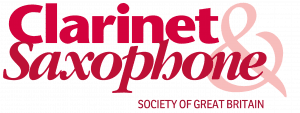The following review is taken from the Summer 2023 issue of Clarinet & Saxophone magazine. For more reviews, news, and features from the single-reed world, join to receive our quarterly magazine and other membership benefits.
RHAPSODY
Huw Wiggin (saxophone) & Noriko Ogawa (piano)
Orchid Classics
Rhapsody is a collaborative project from saxophonist Huw Wiggin and pianist Noriko Ogawa. Despite the cover depicting Wiggin only, the liner notes describe an even-handed creative process with both artists taking responsibility for programming and commissioning. Three new works are presented – by composers Joseph Phibbs, Iain Farrington and Jennifer Watson – complementing Debussy’s Rhapsodie, the album’s anchor work. Pieces by Eric Coates and Franz Liszt complete the programme. The alto saxophone is featured throughout, apart from in Farrington’s and Watson’s works, which showcase the soprano.
Opening the disc, Rhapsodie by Debussy is a substantial work that belies its strange genesis. In 1901, the French-American saxophonist Elise Hall, a Boston socialite and champion of amateur music, pulled off the surprising feat of persuading Debussy to write a piece for her. The composer, reportedly unimpressed by Hall and uninspired by the saxophone, took many years to complete the work, which was not premiered until after his death – and not by Hall, who had lost her hearing by then. (Hall is a fascinating figure; space prevents me from writing more about her here.)
Wiggin and Ogawa give a highly successful performance, using a well-established arrangement of the work by Vincent David. Ogawa’s rendition of the opening is spare and crystalline, while Wiggin plays with subtle delicacy and a gentle fluttering quality to the faster, skittish sections. Debussy-isms abound, including whole-tone scales and opulent harmonies and melodic phrases redolent of La mer and Prélude à l’après-midi d’un faune. As the work gathers pace, Wiggin and Ogawa build towards an impressive climax while summoning effective contrasts through the music’s many twists and turns.
Night Paths by Joseph Phibbs offers an immediate shift in mood, although its rhapsodic nature offers a musical throughline from Debussy. This attractive work is built around five or six episodes that flow freely from one to the other, exploring melancholic, nocturnal expressions. The language is sophisticatedly tonal, eclectic and sometimes jazzy. To my ears there are post-minimalist influences and even some Rite of Spring-style hammering, but the bulk of the work is lyrical. Wiggin is the work’s dedicatee and gives a commanding performance.
I enjoyed Iain Farrington’s Paganini Patterns greatly, especially as it gives us the chance to sample some smooth soprano playing from Wiggin, accompanied with rollocking delight by Ogawa. The style here is cheeky and jazzy, taking outrageous liberties with Paganini’s famous Caprice No.24, which serves as the work’s inspiration. The three movements – fast, slow, fast – create a compelling suite that will please many a concert society audience. A particular highlight is the central movement, entitled ‘Free and expressive’, which provides some touching moments and lush textures.
Next, and really leaning into the ‘light’ music genre, we have Saxo-Rhapsody by Eric Coates, with Wiggin back on the alto. Having been warmed up by the previous work, I was now ready for the Coates – intelligent programming, as this piece may not speak to every listener. For me it outstays its welcome somewhat, but it receives an immaculate performance here and an earns its inclusion as an early major work for solo saxophone and a genial example of Coates’ suave style. Jennifer Watson’s Rhapsody on an Echo Chamber comprises three untitled movements. The first opens with some affecting passagework in the piano, over which Wiggin’s soprano carves out a complex, shapely melodic line. The music ebbs and flows to striking effect, and there is a feeling of a unique musical voice, which offers a refreshing change from the stylistic borrowings of the previous few selections. The second movement is disarmingly simple at first, before blossoming into a sonorous and gently sentimental ballad, while the third solemnly but determinedly brings the piece to a close. This music clearly resonates powerfully with the musicians, who perform it here with great integrity. I look forward to hearing more from this composer.
Wiggin and Ogawa turn to one of the best-known of all rhapsodies for the final work: Liszt’s Hungarian Rhapsody, skilfully arranged by Farrington. This is an abrupt but effective stylistic gear change after the exquisite sounds of the previous work, and the performance here is great fun.
Wiggin and Ogawa are to be congratulated for their work on this record, which offers a densely packed programme of contrasts and treasures. The three newly commissioned works are all winners too, along with Farrington’s show stopping arrangement of the Liszt. This is essential listening for followers of music for piano and saxophone duo.
Chris Walters


